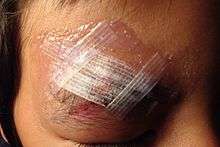Butterfly closure

Butterfly closures are adhesive bandage strips which can be used to close small wounds. They are applied across the laceration in a manner which pulls the skin on either side of the wound together. Butterfly closures may be used instead of sutures (stitches) in some injuries, because they lessen scarring and are easier to care for.
Names
Butterfly closures are often referred to using the genericized trademark Steri-Strips, the brand name used by 3M's Nexcare.[1] The precursor to the Steri-Strip was 3M's Micropore brand of microporous surgical tape.
They are also called butterfly stitches (despite being an alternative to stitches) or butterfly bandages.
Usage

Butterfly closures are ideal for use in highly contoured areas or areas of musculoskeletal movements, such as joints. They are also for use in areas where swelling, edema, hematomas, or bloating may occur. Additionally, they provide wound support following early suture or staple removal. Butterfly closures may also be applied together with special glue to secure the wound.[2]
Benefits
Steri-Strips help prevent maceration. They result in less scarring when compared to staples or sutures. They present a lesser chance of infection than sutures or staples.
Variations
- Reinforced skin closures: These are sterile skin closure strips that are made of a porous, non-woven backing coated with a pressure-sensitive, hypoallergenic adhesive and reinforced with polyester filaments for added strength. They provide general wound support for increased tensile strength and finer wound edge approximation.
- Blend tone skin closures non-reinforced: These are sterile, light beige skin closure strips made of a porous, non-woven backing coated with a pressure sensitive, hypoallergenic adhesive. They blend with and allow the natural skin tone (of light beige people) to show through. They are for use in areas where a cosmetically pleasing appearance is desirable, such as the face or arms.
- Steri-Strips are paper-based, so durability can be compromised if they get wet. Products such as Leukostrip have been developed that are made of a synthetic material that will repel water and therefore remain in place longer.
See also
References
- ↑ "3M US: Nexcare Steri-Strip Skin Closure". 3m.com. Retrieved 2011-03-22.
- ↑ "Stitches and glue care". The Royal Children's Hospital Melbourne. Retrieved 21 January 2015.